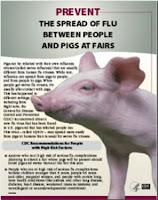PDF
#17,600
Over the past 10 days we've been following reports of two recent swine variant infections in Michigan (see here and here), and today the CDC's FluView report discusses both of them.
The CDC describes Swine Variant viruses in their Key Facts FAQ.There remains some mystery about the first virus, which 3 weeks after detection is still being identified as simply an H3 variant, and a discrepancy between the subtype reported by the local health department (H1N1v) and the CDC (H1N2v) on the second case's subtype.
What is a variant influenza virus?
When an influenza virus that normally circulates in swine (but not people) is detected in a person, it is called a “variant influenza virus.” For example, if a swine origin influenza A H3N2 virus is detected in a person, that virus will be called an “H3N2 variant” virus or “H3N2v” virus.
Over the past dozen years we've seen nearly 500 swine variant cases (H1N1v, H1N2v, H3N2v) reported by the CDC with 307 coming in just one year (2012).
Two months ago the CDC held a webinar for clinicians on recognizing, treating, and reporting zoonotic influenza cases in the community (see COCA Call : What Providers Need to Know about Zoonotic Influenza).
First the CDC update, then I'll have a bit more.
Novel Influenza A Virus
Two human infections with novel influenza A viruses were reported by the Michigan Department of Health and Human Services. One patient was infected with an influenza A(H3) variant (A(H3)v) virus, and the other patient was infected with an influenza A(H1N2)v virus.
The illness associated with influenza A(H3)v infection occurred during the week ending July 22, 2023 (week 29). An investigation by local public health officials found that prior to their illness onset the patient had swine exposure at an agricultural fair where influenza A virus was detected in swine.
The illness associated with influenza A(H1N2)v infection occurred during the week ending July 29, 2023 (week 30). An investigation by local public health officials found that prior to their illness onset the patient had swine exposure at an agricultural fair. This was not the same agricultural fair that the patient infected with influenza A(H3)v had attended.
Both patients are <18 years of age, were not hospitalized, received oseltamivir, and have recovered or are recovering from their illness. No person-to-person transmission of variant influenza A viruses associated with either patient has been identified. The investigations are ongoing.
These are the first variant influenza A viruses reported in the United States in 2023. When an influenza virus that normally circulates in swine (but not people) is detected in a person, it is called a “variant” influenza virus. Most human infections with variant influenza viruses occur following exposure to swine, but human-to-human transmission can occur. It is important to note that in most cases, variant influenza viruses have not shown the ability to spread easily and sustainably from person to person.
Early identification and investigation of human infections with novel influenza A viruses are critical so that the risk of infection can be understood, and appropriate public health measures can be taken.
Additional information on influenza in swine, variant influenza virus infection in humans, and guidance to interact safely with swine can be found at www.cdc.gov/flu/swineflu/index.htm.
The discrepancy between H1N1v and H1N2v is probably a transcription error, and I'm sure will be sorted out in due time. The lack of a full subtype on the H3 virus is a bit more unusual. Hopefully we'll see a more complete characterization - possibly from the National Veterinary Services Laboratories (NVSL) - in the weeks ahead.
